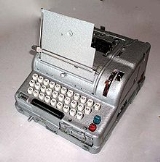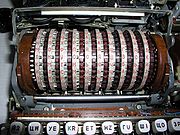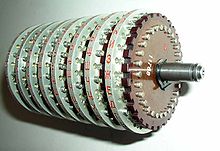
Fialka
Encyclopedia
In cryptography
, Fialka (M-125) is the name of a Cold War
-era Soviet
cipher machine. A rotor machine
, the device uses 10 rotors, each with 30 contacts along with mechanical pins to control stepping. It also makes use of a punched card
mechanism. "Fialka" means "violet
" in Russian
. Information regarding the machine was quite scarce until circa 2005 because the device had been kept secret.
Fialka contains a five-level
paper tape reader on the right hand side at the front of the machine, and a paper tape punch and tape printing mechanism on top. The punched-card input for keying the machine is located on the left hand side. The Fialka requires 24 volt DC power and comes with a separate power supply
that accepts power at 100 to 250 VAC, 50-400 Hz.
The machine's rotors are labelled with the Cyrillic alphabet
, requiring 30 points on the rotors; this is in contrast to many comparable Western machines with 26-contact rotors, corresponding to the Latin alphabet
. The keyboard, at least in the examples of East German origin, had both Cyrillic and Latin markings. There are at least two versions known to exist, the M-125-MN and the M-125-3MN. The M-125-MN had a typewheel that could handle Latin and Cyrilic letters. The M-125-3MN had separate typewheels for Latin and Cyrilic. The M-125-3MN had three modes, single shift letters, double shift with letters and symbols, and digits only, for use with code books and to superencrypt
numeric ciphers.

 The Fialka rotor assembly has 10 rotors mounted on an axle
The Fialka rotor assembly has 10 rotors mounted on an axle
and a 30 by 30 commutator
(Kc 30x30). The commutator consists of two sets of 30 contact strips set at right angles to each other. A punched card is placed between the two sets of contacts via a door on the left hand side of the unit. Each punched card has 30 holes, with exactly one hole per row and column pair, and thereby specifies a permutation
of the 30 rotor contact lines. This feature is comparable to the plug board on the Enigma machine
. A triangular plate was used to enter the null permutation for testing purposes.
There are two types of rotors:
Adjacent rotors step in opposite directions. A spare rotor assembly was kept in unit's top cover.
in NSA parlance) for 24 hours and was changed at 00:01 hours. For the disassemblable rotors, the table also specifies the electrical insert for each outer rotor, which side was to be up, and the orientation of the insert relative to the outer rotor. Here is a sample M-125-3NM day key table for use on the 14th of the month:
The message key table contained the initial rotor settings to be used with each message. A message key was never to be used more than once. The keying material was distributed in a foil-covered package, with the daily key tables and punched cards fan-folded in a pouch with perforations between each item. The other tables were in a side pouch.
, but the NEMA only has 5 electrical rotors vs. the Fialka's 10 and NEMA lacks a punched card commutator or an equivalent, such as a plug board. Fialka seems most comparable to the U.S. KL-7
. KL-7 has eight electrical rotors and also lacks a commutator, but its keyboard permutor switch eliminated the need for a reflector, which proved to be a weakness in the Enigma
system.
Cryptography
Cryptography is the practice and study of techniques for secure communication in the presence of third parties...
, Fialka (M-125) is the name of a Cold War
Cold War
The Cold War was the continuing state from roughly 1946 to 1991 of political conflict, military tension, proxy wars, and economic competition between the Communist World—primarily the Soviet Union and its satellite states and allies—and the powers of the Western world, primarily the United States...
-era Soviet
Soviet Union
The Soviet Union , officially the Union of Soviet Socialist Republics , was a constitutionally socialist state that existed in Eurasia between 1922 and 1991....
cipher machine. A rotor machine
Rotor machine
In cryptography, a rotor machine is an electro-mechanical device used for encrypting and decrypting secret messages. Rotor machines were the cryptographic state-of-the-art for a prominent period of history; they were in widespread use in the 1920s–1970s...
, the device uses 10 rotors, each with 30 contacts along with mechanical pins to control stepping. It also makes use of a punched card
Punched card
A punched card, punch card, IBM card, or Hollerith card is a piece of stiff paper that contains digital information represented by the presence or absence of holes in predefined positions...
mechanism. "Fialka" means "violet
Violet (plant)
Viola is a genus of flowering plants in the violet family Violaceae, with around 400–500 species distributed around the world. Most species are found in the temperate Northern Hemisphere; however, viola species are also found in widely divergent areas such as Hawaii, Australasia, and the Andes in...
" in Russian
Russian language
Russian is a Slavic language used primarily in Russia, Belarus, Uzbekistan, Kazakhstan, Tajikistan and Kyrgyzstan. It is an unofficial but widely spoken language in Ukraine, Moldova, Latvia, Turkmenistan and Estonia and, to a lesser extent, the other countries that were once constituent republics...
. Information regarding the machine was quite scarce until circa 2005 because the device had been kept secret.
Fialka contains a five-level
Baudot
Baudot:*Marc Antoine Baudot , deputy during the French Revolution*Émile Baudot , French telegraph engineer, inventor of the Baudot code*Anatole de Baudot , French architect...
paper tape reader on the right hand side at the front of the machine, and a paper tape punch and tape printing mechanism on top. The punched-card input for keying the machine is located on the left hand side. The Fialka requires 24 volt DC power and comes with a separate power supply
Power supply
A power supply is a device that supplies electrical energy to one or more electric loads. The term is most commonly applied to devices that convert one form of electrical energy to another, though it may also refer to devices that convert another form of energy to electrical energy...
that accepts power at 100 to 250 VAC, 50-400 Hz.
The machine's rotors are labelled with the Cyrillic alphabet
Cyrillic alphabet
The Cyrillic script or azbuka is an alphabetic writing system developed in the First Bulgarian Empire during the 10th century AD at the Preslav Literary School...
, requiring 30 points on the rotors; this is in contrast to many comparable Western machines with 26-contact rotors, corresponding to the Latin alphabet
Latin alphabet
The Latin alphabet, also called the Roman alphabet, is the most recognized alphabet used in the world today. It evolved from a western variety of the Greek alphabet called the Cumaean alphabet, which was adopted and modified by the Etruscans who ruled early Rome...
. The keyboard, at least in the examples of East German origin, had both Cyrillic and Latin markings. There are at least two versions known to exist, the M-125-MN and the M-125-3MN. The M-125-MN had a typewheel that could handle Latin and Cyrilic letters. The M-125-3MN had separate typewheels for Latin and Cyrilic. The M-125-3MN had three modes, single shift letters, double shift with letters and symbols, and digits only, for use with code books and to superencrypt
Superencryption
Multiple encryption is the process of encrypting an already encrypted message one or more times, either using the same or a different algorithm. The terms cascade encryption, cascade ciphering, multiple encryption, multiple ciphering, and superencipherment are used with the same meaning...
numeric ciphers.
Encryption mechanism


Axle
An axle is a central shaft for a rotating wheel or gear. On wheeled vehicles, the axle may be fixed to the wheels, rotating with them, or fixed to its surroundings, with the wheels rotating around the axle. In the former case, bearings or bushings are provided at the mounting points where the axle...
and a 30 by 30 commutator
Commutator
In mathematics, the commutator gives an indication of the extent to which a certain binary operation fails to be commutative. There are different definitions used in group theory and ring theory.-Group theory:...
(Kc 30x30). The commutator consists of two sets of 30 contact strips set at right angles to each other. A punched card is placed between the two sets of contacts via a door on the left hand side of the unit. Each punched card has 30 holes, with exactly one hole per row and column pair, and thereby specifies a permutation
Permutation
In mathematics, the notion of permutation is used with several slightly different meanings, all related to the act of permuting objects or values. Informally, a permutation of a set of objects is an arrangement of those objects into a particular order...
of the 30 rotor contact lines. This feature is comparable to the plug board on the Enigma machine
Enigma machine
An Enigma machine is any of a family of related electro-mechanical rotor cipher machines used for the encryption and decryption of secret messages. Enigma was invented by German engineer Arthur Scherbius at the end of World War I...
. A triangular plate was used to enter the null permutation for testing purposes.
There are two types of rotors:
- disassemblable (zerlegbar) rotors, used with M-125-3MN. Rotorset name is "PROTON." The disassemblable rotors consisted of an insert with electrical contacts and scramble wiring, and an outer ring with mechanical pins whose presence or absence controlled rotor stepping. As part of the key setup, the stepping control pins could be rotated relative to the outer ring. The inner, electrical ring could also be rotated relative to the outer ring and could be inserted in one of two ways, with side 1 or side 2 up.
- unitary rotors, used with M-125-MN. These had both electrical contacts and mechanical pins. The only key adjustment was the order of the rotors on the axle and the initial rotor settings. There was one combination for the disassemblable rotors that was compatible with the unitary rotor. One East German manual that has become public contains typed-in and hand written addenda that suggest the East Germans, at least, later stopped using the added features of the disassemblable rotors and only used them in unitary compatibility mode.
Adjacent rotors step in opposite directions. A spare rotor assembly was kept in unit's top cover.
Keying material
The keying material for the Fialka consists of a daily key book, a message key book and a message identifier book for broadcast traffic. The daily key book contains day keys for one month. A day key consists of a key table (in Cyrillic) and a punched card. For fixed rotor systems, the key table specifies the order of the rotors on the axle and the initial rotor settings to be used to decrypt the indicator of broadcast messages. As its name implies, day key is valid (has a cryptoperiodCryptoperiod
A cryptoperiod is the time span during which a specific cryptographic key is authorized for use. Common government guidelines range from 1 to 3 years for asymmetric cryptography, and 1 day to 7 days for symmetric cipher traffic keys....
in NSA parlance) for 24 hours and was changed at 00:01 hours. For the disassemblable rotors, the table also specifies the electrical insert for each outer rotor, which side was to be up, and the orientation of the insert relative to the outer rotor. Here is a sample M-125-3NM day key table for use on the 14th of the month:
- ИДЖЗА ВКБГЕ 14
- OCAHE PTБВЕ
- БДВИА ГЕЗКЖ
- 2II22 I22I2
- КУЛКЮ ЫХВУГ
The message key table contained the initial rotor settings to be used with each message. A message key was never to be used more than once. The keying material was distributed in a foil-covered package, with the daily key tables and punched cards fan-folded in a pouch with perforations between each item. The other tables were in a side pouch.
Comparison with other rotor machines
The Fialka design seems to derive from the Swiss NEMANEMA (machine)
In the history of cryptography, the NEMA , also designated the T-D , was a 10-wheel rotor machine designed by the Swiss Army during World War II as a replacement for their Enigma machines.-History:The Swiss became aware that their current machine, a commercial Enigma , had been broken by...
, but the NEMA only has 5 electrical rotors vs. the Fialka's 10 and NEMA lacks a punched card commutator or an equivalent, such as a plug board. Fialka seems most comparable to the U.S. KL-7
KL-7
The TSEC/KL-7, code named ADONIS and POLLUX, was an off-line non-reciprocal rotor encryption machine. The KL-7 had eight rotors to encrypt the text, seven of which moved in a complex pattern, controlled by notched rings. The non-moving rotor was in fourth from the left of the stack. The encrypted...
. KL-7 has eight electrical rotors and also lacks a commutator, but its keyboard permutor switch eliminated the need for a reflector, which proved to be a weakness in the Enigma
Enigma machine
An Enigma machine is any of a family of related electro-mechanical rotor cipher machines used for the encryption and decryption of secret messages. Enigma was invented by German engineer Arthur Scherbius at the end of World War I...
system.
External links
- Fialka Cipher Machines — by Tom Perera
- Detailed info on Fialka — by Paul Reuvers
- Fialka Cipher Machines — by Nick Gessler
- RUSSIAN M-125 FIALKA
- A Simulation of M125MN and M125-3MN find under http://scz.bplaced.net/d/m125v4.rar
- An illustration about a KGB operative using Fialka by artist TD http://234mmskull.deviantart.com/#/d3bj002

